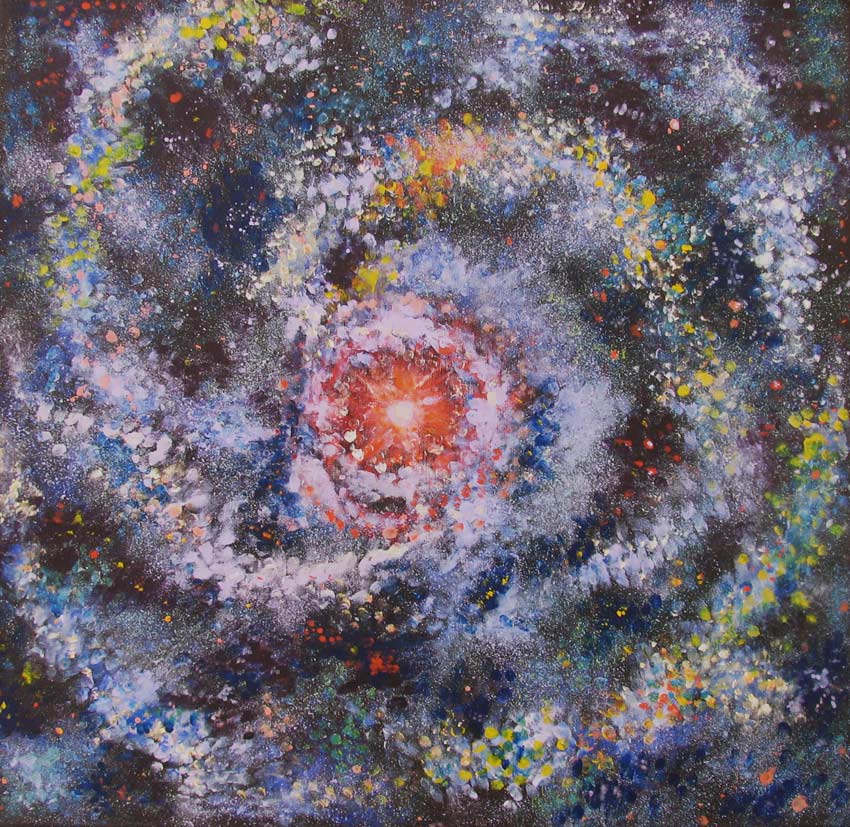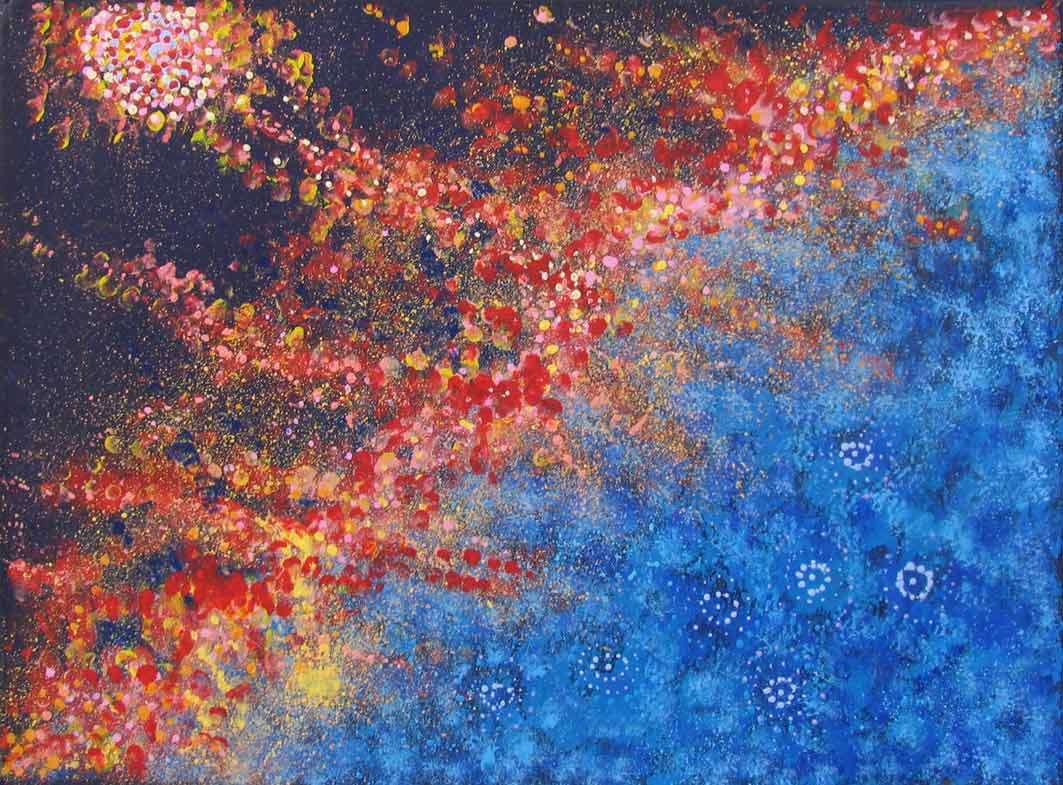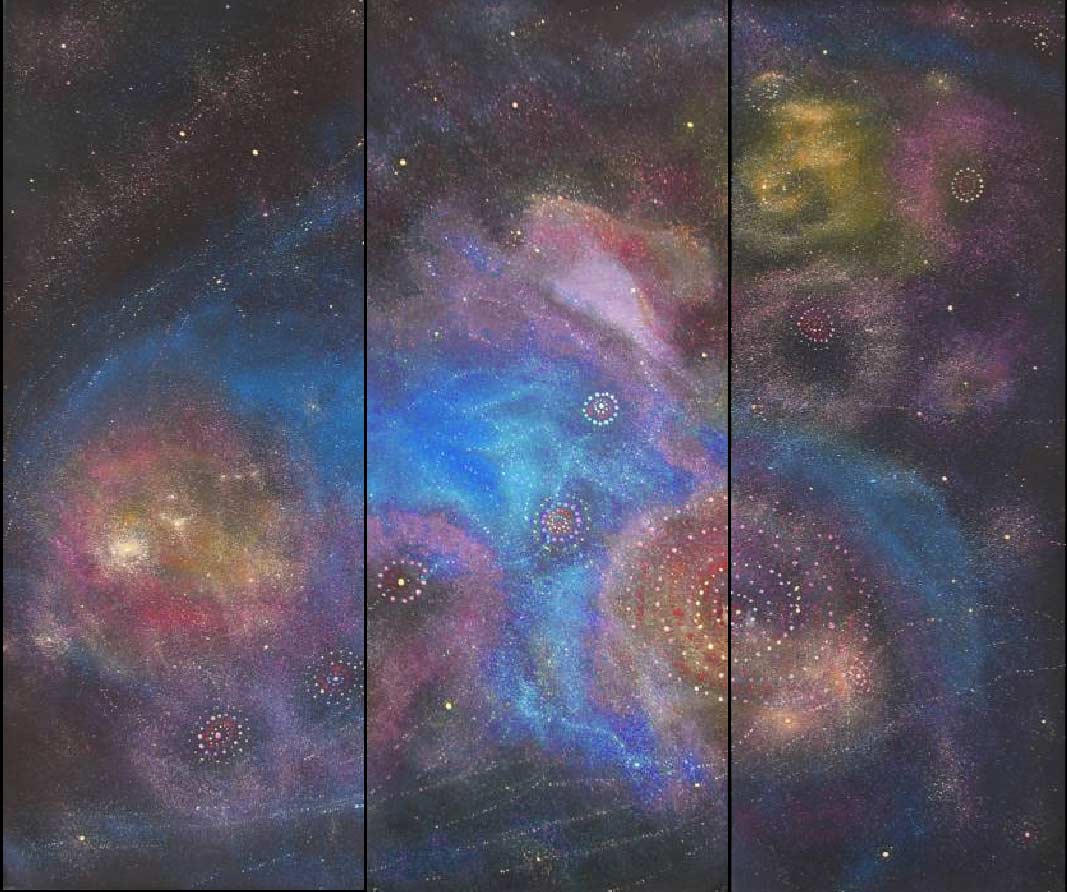When you enter our black gallery you will feel as if you have been swept up in to the heavens and are swirling around the Milky Way! This is the immediate effect of our solo exhibition of works by Alma Nungarrayi Granites - a painter fast gaining renown in the Aboriginal art scene.

Alma Nungurrayi Granites 'Yanjirlpirri or Napaljarri - Warnu Jukurrpa (Star or Seven Sisters Dreaming)' 91x91cms AGRWU796-12
Alma comes from a family of great painters. Her father and mother, Paddy Japaljarri Sims and Bessie Nakamarra Sims, are founding members of the art movement at Yuendumu; a remote community 300km north west of Alice Springs, on the southern fringes of the Tanami Desert. Alma has lived most of her life in Yuendumu and met her husband while they were school children at the local school. She has three daughters and many grandchildren.
Throughout Alma’s life, there has been an emphasis on education. Alma worked as a staff member at the local school in Yuendumu, teaching the local Walpiri language as well as English. Alma would observe elders visiting the school on a regular basis to teach the younger generation about the Jukurrpa (Dreaming) and associated country.
Alma herself became interested in learning more about her heritage and traditions, and decided to attended courses run by the Old Peoples Program and Adult Education Centre. As Alma’s interest in her background grew she learnt more from her aunties, mother, father and other family members about their songs and country where the Jukurrpa takes place. The ethos of not only learning cultural practices, but bridging traditional Warlpiri life to the new enforced ‘white fella’ way of life is something that Alma tries to apply to her painting career.
 Alma Nungurrayi Granites 'Yanjirlpirri or Napaljarri - Warnu Jukurrpa (Star or Seven Sisters Dreaming)' 46X61cms AGRWU499-12
Alma Nungurrayi Granites 'Yanjirlpirri or Napaljarri - Warnu Jukurrpa (Star or Seven Sisters Dreaming)' 46X61cms AGRWU499-12
When Alma stopped working as a teacher’s assistant, she started painting at the local art centre. However it was not until 2007 that Alma started to paint in earnest. She applied herself and experimented with composition and artistic techniques, while still remaining true and respectful to her Warlpiri culture.
One of the key subjects of Alma’s works is an epic love story; Napaljarri-wanu Jukurrpa (Seven Sisters Dreaming) is the story of the seven ancestral Napaljarri sisters. An ancestral Jakamarra man was in love with the seven Napaljarri sisters and chased them. In a final attempt to escape from the Jakamarra, the sisters turned themselves into fire and ascended to the heavens to become stars. The seven Napaljarri sisters can be found in the night sky today as a cluster of seven stars that is part of the constellation of Taurus (also known as the Pleiades). Jukurra-jukurra (the morning star) is the Jakamarra man, still chasing the Napaljarri sisters across the night sky.
Alma constantly questions her parents and aunties to gain more detailed information and insight in to the stages and sites where the Jukurrpa takes place. With this knowledge, Alma has managed to assertively depict her Jukurrpa with an exuberance and richness which make them the focal point of any setting.

Alma Nungurrayi Granites - Triptych 'Yanjirlpirri or Napaljarri - Warnu Jukurrpa' 122x138cm AGRWU3714/12, AGRWU3713/12, AGRWU3715/12
Alma has also mastered the triptych, and we have a selection in our current exhibition that can be separated or placed closely together as one piece. The separation between the elements and key ancestral figures enhances the tension between the subjects in the painting.
Alma’s paintings have a strong presence, which not only communicates the tension of the story, but the calm and whimsical nature of the night sky. This spectacular exhibition opens with a preview on Thursday 21 March until 8pm at 680 Darling Street, Rozelle, so come along and join us for a glass of wine, view these stellar works, and be transported into the spacey depths of Alma’s paintings. All artworks are for sale of course, and you can acquire your own very reasonably priced piece of the universe directly from the gallery or through our secure payment portal online. Artworks can be viewed on Alma's exhibition page right now and as we are open until 9pm this evening, you are welcome to join us for a special preview.